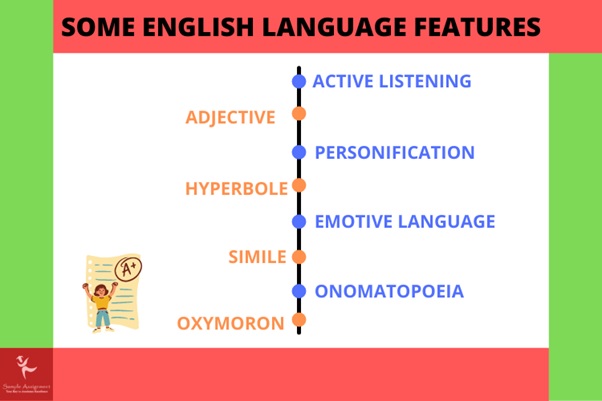
Have you ever wondered what is our secret to achieving high grades in language papers? How do our experts use each language feature properly? Or for that matter, what language features even are? Any word that adds meaning to your sentence or enhances the quality of your work is called a language feature. Writers all around the world make use of these features to convey their message through their writing. From nouns to vocabulary to sentence structure, even adjectives and punctuation are part of the language features. However, the problem most people face is how to use these and define language features correctly.
What Do Language Features Mean?
The language features vary according to the kind of text and the meaning you want to convey. Thus, many students are unaware of how and when to use these writing features. Your choice can vary depending upon the purpose of your text, target audience, and subject matter. To draft an essay brilliantly, you need to understand the complexities of these features in detail. That is why today we will be discussing the different language features that can enhance the quality of your work.
Language is an essential part of everyone’s life as it is the main way of communicating with others. Literally taken, language features mean examining the language and understanding what the writer is saying. Writers can use various techniques like figures of speech, word choices, and sentence structure to improve their work.
What Are Language Features In English?
The English language is vast, and we can only hope to explore all these features in our lifetime. However, our professionals have been making use of different English language features for decades now.
Language Features List
Some popular Language Features are explained below in the Language Features List:
- Allegory
- Alliteration
- Allusion
- Analogy
- Anaphora
- Antithesis
- Assonance
- Emotive language
- Dramatic irony
- Euphemism
- Homonym
- Imagery
- Hyperbole
- Mood and tone
- Litotes
- Metaphor
- Oxymoron
- Pathos
- Satire
- Zeugma
- Pun
- Symbolism
We will now discuss a few types of language features-
What Is An Allegory?
A picture, poem, or story that has a hidden meaning, that is usually related to political insights or moral value is an allegory. It can be used to convey a symbolic message about the real world. An allegory is a language feature that helps you enhance the way you want your readers to perceive the message in your work. In fact, if a story has a fixed meaning, allegories can be used to develop the different layers of meaning. For example, 'The Animal Farm' by George Orwell seems to be about a group of animals who rebel against the farmers. However, on closer view, it highlights the situation of the erstwhile Soviet Union and how it was led by Joseph Stalin.
What Are Alliterations?
Take a look at this sentence:
Larry’s leopard likes leaping lizards.
What stands out in this line? All the words start with the same letter and that is what alliterations are about. Alliterations are fun to hear and can be used to draw the reader’s attention to certain words in the document, thereby emphasising them. Alliterations are among the most interesting language features in English. Some examples of language features and alliterative sounds are given below:
'Pied Piper picked a peck of pickled peppers.'
Heavenly Hillsboro, the buckle on the Bible belt.
In the second sentence, there is a repetition of the ‘b’ and ‘h’ sounds. The former is a persuasive language feature and has a sharp effect whereas the latter imparts a soothing effect. Thus, alliterations can be used if you want your audience to focus on certain words.

What Is An Analogy?
An analogy is one of the best features that can be used in a persuasive essay. Since persuasion is all about helping your readers see your point of view and make them understand what you are communicating through your work. However, your audience will only understand your argument if you make sound arguments and back them up with well-targeted theories and facts that come to an unavoidable conclusion. Thus, when it comes to a persuasive essay, analogies are difficult to beat. A great example of an analogy is:
'Just as the caterpillar comes out of its cocoon, so we must come out of our comfort zone.'
In a sentence like this, an analogy has been used to link or compare the transition of a butterfly from a caterpillar with the different stages of change for a human being. This kind of example shows us that just like a caterpillar has to change itself inside the cocoon to be able to fly away, humans also need to come out of their comfort zone to grow in life. Persuasive, right?
What Is A Metaphor?
A metaphor is used when you want to talk about similar things and link them with the words ‘like’ or ‘as’. This is a considerably basic definition of metaphors. However, in other words, it is a language technique that can be used to attract your reader’s attention. If you want your writing to stand out, a metaphor will help you do this logically. It can also help you inspire your readers to act or change their beliefs if you can use them logically. Metaphors make your writing more memorable, personal, and persuasive. Here is an example of a metaphor:
“Walt becomes a real pig when he starts eating.”
Would you have ever thought of the words ‘Walt’ and ‘pig’ in relation? No. But with the correct metaphor, you can understand what the writer is trying to convey through their work.
These are some of the common features of language that are used across different kinds of academic documents, assignments, books, journals, etc. However, this is not the end of the list. Thus, if you want help understanding any other features, do not hesitate to reach out to us.
Language Features Examples
There are several examples of language features used to develop engaging content data effectively, such as
- Figurative Language: It is a form of expressing oneself that does not employ a real meaning. Also, it is common in exaggerations and comparisons; it is used to add creative flourish to spoken or written language or define a complex perspective. The opposite form of figurative language is literal language or using phrases reflecting the exact meaning of words without exaggeration or imagination.
- Colloquial Language: A colloquial language is commonly used, for instance, in texts and informal emails. There is no need for informal content such as memos, meetings, and many more. As a literary device, it would be employed in theater and fiction, especially in the narration of characters, more likely in lyric form.
- Simile: It is a figure of speech and form of metaphor that compares two things using the words like "as." The main objective of simile is to assist in describing one thing by comparison to another that is perhaps seemingly unrelated. For instance, in Forrest Gump, the 1994 film, the protagonist uses the simile "Life is like a box of chocolates." He focuses on how unpredictable life is; in the same way, you don't know the taste of the chocolate until you taste it.
- Consonance: The repetition of the same consonant sounds in the text. Mainly, the sound can be found in the middle or end, or at the end of stressed syllables, not anywhere in the world. Did you know? Since the 1580s, the recent definition of consonance as a literary device has been preferred. It is an important device in the construction of half-rhymes. Moreover, a looser rhyming approach is seen in hip-hop music and poems. For more information, connect with our online assignment help experts.
What Are The Language Forms And Features?
Now that we have discussed a few features, let us see how these forms and features affect a person’s writing. The following forms and features are quite popular in the English language and you need to know their definition as well as the correct way to use them to write clearly.
The Mood And Tone-
The difference between tone and mood has always perplexed students. This is because the mood is the literary element that is responsible for invoking certain emotions or feelings in the reader’s mind through your work. On the other hand, your tone is representative of the attitude with which you are writing the story. Sometimes, a language feature and its effects will show you that the tone of a story may be bossy or sassy, or rude. A funny story can have sarcastic tones and a serious one can have humorous tones. How does this happen? Through the choice of certain words, and proper sentence construction.
The mood of the story is what the audience will feel while reading the essay or story. It is the vibe of your work that comes across to the audience while they read it. It can be light, dark, rushed, heavy, or happy. It is responsible for setting the theme of your essay and making it relatable to the readers.
A Pun-
How many times have you read a sentence and see it followed by the term ‘pun intended? Well, a pun is a humorous use of a particular word that is used to convey a different meaning than the original. Puns can be used in your work if you want to express something funny or witty. It may not make your audience laugh, but it will definitely make them smile. Two great language features and examples of puns are given below:
'Did you hear about the kid who thought he was a giraffe? It was a tall story'.
In this sentence, the phrase ‘tall story’ is related to the ‘giraffe’ and expresses that the initial question was actually a lie and was merely an attempt to crack a joke.
Similarly, in the last scene of ‘Silence of the Lambs’, Hannibal Lecter says:
‘‘I am going to have some friends for dinner.’’
Here, he means this literally because he portrays the character of a cannibal in the movie.
Puns, mood, and tone can be used in narrative essays to present your thoughts vibrantly. The list of English language features is also endless. However, it is up to you to use these features carefully and in a manner that will enhance the quality of your writing without making it seem sloppy and abrupt.
So, What Did We Learn Today?
Language features are a complex and vast topic. However, they are essential in an English assignment writer's life as they help their clients to convey their thoughts and emotions effectively. They are also used in a deliberate attempt to catch the reader’s attention and also retain it in the long run.
Most importantly, as we have discussed today, language features help the audience connect with your work and identify the different emotions behind it. With this blog post today, we have hoped to dive into the world of language features briefly and understand their importance.
If you are still unable to understand any concept or need some essay writing help samples to see how these features are used in academic papers, reach out to us today! Our academic support team is available round-the-clock to help you out. Good luck!
Order Now @ Upto 50% Off
Get
Flat 50% Off
on your Assignment Now!

















Loved reading this Blog? Share your valuable thoughts in the comment section.
Add comment